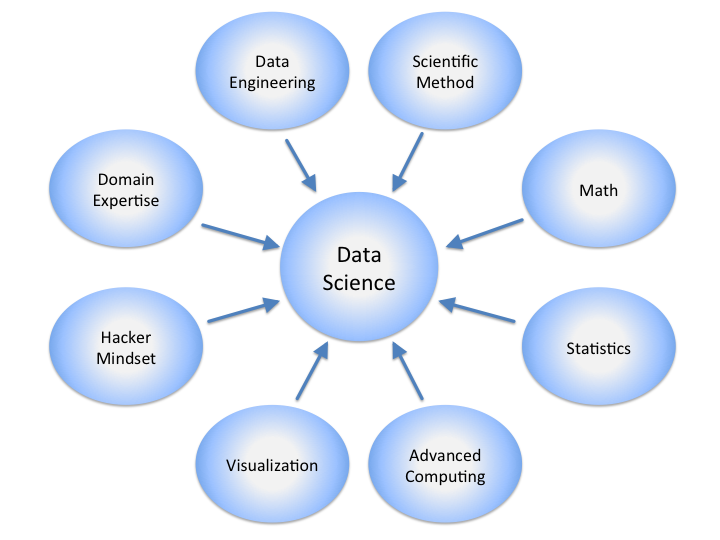Learn how to become a data scientist with this step-by-step guide. Explore key skills, education requirements, tools, and resources to kick start your career in data science. Start by building a strong foundation in programming languages like Python and R, and learn data manipulation using SQL. Strengthen your understanding of statistics, mathematics, and machine learning algorithms.

Understand What Data Science:
Data scientist is the practice of extracting meaningful insights and knowledge from raw data. It combines fields like statistics, mathematics, computer science, and domain expertise to analyze and interpret complex data.
Data scientist involves extracting meaningful insights from data using statistical analysis, machine learning, and data visualization.Responsibilities include data cleaning, exploration, building predictive models, and communicating findings.
Steps to Become a Data Scientist:-
- Degree: A bachelor’s degree in computer science, mathematics, statistics, engineering, or a related field is helpful.
- Advanced Degree (Optional): A master’s or Ph.D. in data science, machine learning, or a related field can give you an edge.
Develop Key Skills:
Programming:
Programming is a core skill for data scientists, enabling them to manipulate data, implement algorithms, and build models effectively. Here’s a breakdown of the essential programming skills required:
Python:
Widely used for data manipulation, analysis, and machine learning.
- Libraries to learn:
- Pandas: For data manipulation.
- NumPy: For numerical computations.
- Scikit-learn: For machine learning.
- Matplotlib/Seaborn: For data visualization.
- TensorFlow/PyTorch: For deep learning.
R :
- Popular in statistics and data visualization.
- Libraries to learn:
- ggplot2: For visualization.
- dplyr: For data manipulation.
- caret: For machine learning.
Database Management:
Database Management System (DBMS) is a software used to manage data from a database. Database management is the process of organizing, storing, and manipulating data in a database. A Database Management System (DBMS) is the software that allows users to interact with a database.
SQL (Structured Query Language) is a standard language for accessing and manipulating data in a relational database.
Data Visualization:
Visualization makes complex data easier to understand and interpret by using graphs, charts, and dashboards.
Types of Visualizations:
- Univariate Analysis:
- Bar plots, histograms, pie charts for single variables.
- Multivariate Analysis:
- Scatter plots, heatmaps for relationships between variables.
- Temporal Data:
- Line charts to show trends over time.
- Geospatial Data:
- Maps for geographic data (e.g., choropleth maps).
Work on Real-World Projects:-
10 real-world data science project ideas that can be implemented in various industries. These Projects offer a practical way to apply data science techniques and demonstrate their potential impact on business outcomes. Sentiment Analysis for Social Media, Image Recognition for Security & etc.
Analyze datasets from Kaggle, UCI ML Repository, or public APIs.Build end-to-end projects and showcase them on GitHub. Example of real time Projects.
- Sentiment Analysis for Social Media
- Customer Segmentation for Retailers
- Price Optimization for Airlines
- Traffic Optimization for Smart Cities
- Movie Recommendation System for Entertainment
- Image and Video Analysis for Content Moderation
Internships:
Internships are a great way to gain practical experience, build your portfolio, and network within the field of data science. Here’s how to find and make the most of them.
You can find a data scientist internship by searching for available internships on a job posting website or by searching for internships on a business’ dedicated job page.
Job Portals:
LinkedIn: Search for “Data scientist Internships.”
Indeed, Glassdoor, and Naukri (for Indian opportunities)
AngelList (for startups)
Company Websites: Regularly check the career pages of companies you admire.
Prepare to Apply:-
Resume Tips
- Highlight Relevant Skills: Python, R, SQL, machine learning, data visualization.
- Showcase Projects: Include links to your GitHub portfolio.
- Quantify Achievements: Use metrics (e.g., “Increased prediction accuracy by 15% in a machine learning project”).
Build a Portfolio:-
Building a strong portfolio is key to showcasing your data science skills. Here’s a brief guide on how to do it.
- Include Real-World Projects
- Show End-to-End Work
- Use GitHub
- Visualize Your Results
- Add Documentation
- Highlight Key Skills
- Follow industry trends, attend meetups, and connect with professionals Online.
- Follow Industry Trends, Attend Meetups, Connect with Professionals Online & Build and Share Your Own Content.
- Connect with Professionals Online.
Courtesy:- chatgpt.com

